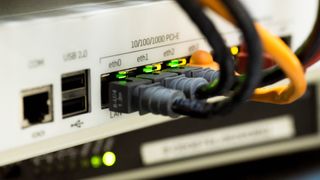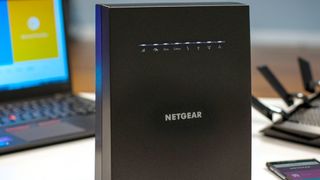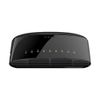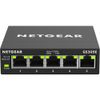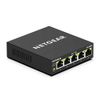In a tech-first world, it's important to build a reliable home network, and this is where the best ethernet switches come in. Wi-Fi does its best, and as Wi-Fi 6 E and 7 arrive, wireless is beginning to become a genuine alternative to a wired network. But in terms of speed and reliability, Ethernet still comes out on top, and if you're using it you're going to need one of the best Ethernet switches too.
An Ethernet switch is essentially a hub that allows you to connect more devices to your network than you normally would. So if you want to connect your TV, home computer, video games console and more to your wired network, you’ll need a switch. Most standard home routers have four Ethernet ports on the back, but this relies on you having four devices that are in easy range of the router. If your network operates over multiple floors, you'll want to run one cable up the stairs and put a switch on the end to plug multiple devices into.
The best Ethernet switches can easily handle the demands of a busy household with tonnes of devices. They can add ten or more ports to your network and come in a variety of speeds as well as offering the choice of managed or unmanaged. A managed switch offers you the chance to log into it over the network and play with the settings, which is fine for a business setting, but for home use you'll be able to make do with the cheaper unmanaged switches.
It's also worth checking out the best wireless routers so you have all your connections working their best. The best home computers will also be the perfect component to your well-running network.
Best ethernet switches
Why you can trust Top Ten Reviews
This list lines up the best ethernet switches out there right now, each with varying amounts of ports and at different prices.
While we strive to review every product that we highlight, some of the reviews for this guide are still in progress. However, any unreviewed products will sum up the key specs, features and user reviews to help you make the best decision for you and your household.
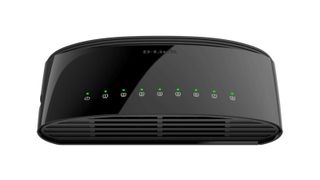
The D-Link DGS-1008G is our top pick. It does everything you need an Ethernet switch to do, with fast speeds and low running costs.
What the experts say
We tested 5 of the best Ethernet switches on the market in 2021 from manufacturers like NETGEAR, TP-Link, and more. We have researched the varying types of Ethernet switch and identified which situations they each suit best. We also brought together over 5000 user reviews to round out this comprehensive expert guide.
Our promise to you
When it comes to the best Ethernet switches, the experts tend to be the companies that are manufacturing them. NETGEAR, D-Link, TP-Link, Linksys - these are the big names in consumer Ethernet switches, but there are also companies like Cisco who specialize in kitting out businesses and corporations with Ethernet switches.
Obviously each of these companies will want to direct you to its own products, but they can all offer important insights and advice too. NETGEAR has recommendations for Ethernet switches based on your needs, whether it be for home, business or gaming use.
Cisco also has a solid guide which runs you through each type of Ethernet switch, explaining unmanaged and smart switches, as well as managed switches and why they're probably overkill for domestic use.
Best Ethernet Switch Overall

The D-Link DGS-1008G is our top pick for both home and small businesses - it has good looks, great features and it doesn't the cost the world. It features eight Gigabit ports with a total switching capacity of 16 Gbps.
The outer shell is made from plastic with a matte black finish. It's modern and unobtrusive, so it will fit in to a workplace set up or in a corner of your living room - after all, you don't want your Ethernet switch being a standout piece in the room. The DGS-1008G is also an unmanaged switch, so it's super easy to set up and use, and the fanless design makes it quiet to run too.
The D-Link DGS-1008G has a score of 4.6 stars out of 5 on Amazon with 1,935 ratings. Users were pleased with the D-Link DGS-1008G’s performance and ease of use, but some criticized its longevity and not occasional disconnects.
One standout feature we liked is that the D-Link DGS-1008G prioritizes important data packets automatically, giving you access to your full network speeds for intensive tasks like online gaming or video calling.
If you’re environmentally conscious, or just worried about your energy bills then you’ll also be pleased to hear that the D-Link DGS-1008G uses D-Link’s Green Technology which keeps energy usage down. The shell is even made from recycled plastic. Oh, and it comes with a limited lifetime warranty.
- Read our full D-Link DGS-1008G review
Best for business
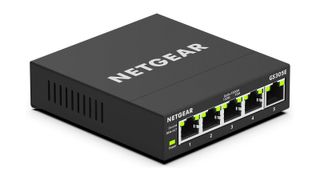
With sizes ranging from five ports for home use all the way up to 48 port switches for businesses, the Netgear GS305E is a versatile Ethernet switch that is great for a multitude of customers.
This model supports Gigabit (1000Mb) speeds, so it should be more than capable to withstand the requirements of a busy household or even your work network needs. It also has a fanless design that means that it's whisper quiet too - great for keeping it housed in a living space.
The Netgear GS305E has a score of 4.7 stars out of 5 on Amazon with 2,154 ratings. Positive reviews said that it was a “user-friendly” solution and that it has a great cable management system. Negative reviews are rare, with only 2% rating it one star, but some users noted difficulty setting up the switch with Netgear software.
NETGEAR is a quality manufacturer known for its well-built and sturdy devices, and the Netgear GS305E is no exception - this is a robust piece of kit with a metal case. It’s energy efficient too, which is ideal if you’re going to have it running 24/7.
This model sits in NETGEAR's Smart Managed Plus range, which means it has some basic network monitoring capabilities and configuration options, but it doesn't require the advanced software that most business-first switches do. Some workplaces might require more advanced management options, but this is a great choice for those that don't.
Best eco-friendly
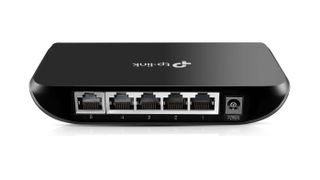
When shopping for one of the best Ethernet switches, it's important to consider brand legacy. The TP Link TL-SG1005D is from a brand you can trust and offers easy setup. It's plug and play, so you don't need to worry about setting it up or installing software. This is great for those just using it in their homes, or less tech savvy users.
It also offers five Gigabit Ethernet ports using IEEE 802.3x flow control for reliable and fast data transfer with non-blocking switching.
The TP Link TL-SG1005D has an average score of 4.7 stars out of 5 on Amazon with a staggering 26,893 user ratings. Happy customers noted that it offered “ Great performance for the price” and that it works seamlessly with no issues setting up. While reviews were overwhelmingly positive, some users did note inconsistent speeds.
The TP Link TL-SG1005D is also one of the most affordable switches in our roundup. It's cheap to buy and features energy-saving technology to keep running costs down by automatically shutting down idle ports. This can result in an up to 80% power use reduction which is great news for your household bills.
The two-year manufacturer warranty also provides peace of mind in your purchase, and 24/7 tech support from TP means you can get any problems sorted quickly.
- Read the full TP Link TL-SG1005D review
Best value for money
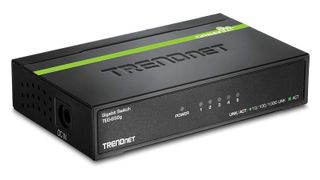
If you're on the hunt for a budget Ethernet switch, then the TrendNET TEG-250g is another excellent choice. If you need a small, unmanaged switch for your home then the five ports should provide ample room for your devices. It also has a 10Gbps switching capacity to help deal with data traffic spikes, reducing bottlenecks and slowdown. The robust metal shell will also be durable.
The TrendNET TEG-S50g has a score of 4.6 out of 5 stars on Amazon with 2,168 ratings. Users praised how user-friendly and easy to setup the device is, but some low-scoring reviews criticized that the switch is noisy.
Energy saving features are becoming more common across Ethernet switches, and the TrendNET TEG-S50g is no different. It has sensors that detect when ports are vacant and inactive, and it regulates power usage accordingly to keep your energy bills down. This feature can drop power usage by up to 70%.
It also has a plug and play setup which makes using this switch super simple. There are some management features you can access if you wish though, including data prioritization for audio and video downloads, full-duplex mode and jumbo frame support.
- Read the full TrendNET TEG-S50g review
Best user reviews
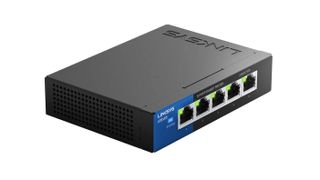
Linksys is a huge name when it comes to computer connectivity, so you can sleep easy knowing that this switch is from a reputable brand. The LGS105 is a great choice for either the home or the office as it comes in a five port, eight port, 16-port and 24-port variations, so you can scale up depending on your needs.
The Linksys LGS105 has an impressive average score of 4.8 out of 5 stars on Amazon with 3,344 ratings. Positive reviews noted the excellent performance, even with long LAN cables. They also praised the easy setup and reliability. Negative reviews noted some inconsistencies in connections.
Offering Gigabit transfer speeds and plug and play, there should be no issues when it comes to getting it set up. Simply plug it in, attach the Ethernet cables and away you go.
The Linksys LGS105 is also a good choice for budget conscious buyers, thanks to a reasonable cost and as it meets the 802.3az standard for energy efficiency. As part of this, the Linksys LGS105 features auto detection on its ports, meaning it only draws power for ports when they're in use, keeping energy usage down.
Ethernet switch buying advice
What is an Ethernet Switch?
An Ethernet switch is a home networking device designed to connect several wired Ethernet devices to a network through one Ethernet connection to your router. Ethernet switches are useful if you have more wired devices than ports on your router, or if there are several wired devices in the same area that is far away from your router. Switches organize the information passing through the router to optimize transfer speeds. In this way, switches differ from older Ethernet hubs, which are similar devices that split a single Ethernet connection among multiple inputs and outputs. Instead of sorting the information and sending data only to the intended destinations, hubs repeat data to all locations besides the origin, which can slow down a network significantly.
Ethernet switches are also distinct from routers. Routers manage your home network. They connect to your modem and every other internet-using device in your home, either through wired or wireless connections. Routers generally have more than one Ethernet port, as well as network switching capabilities similar to those of Ethernet switches. Although a router with multiple ports could be used in place of a switch, an Ethernet switch cannot replace a router in your home networking setup, for various functional and security reasons. Your Ethernet switch should be connected to your router through a wired connection. The order of networking equipment from your ISP connection should be the modem, router, Ethernet switch (optional) and your device. Because they are wired, Ethernet switches are also different from wireless network switches and wireless access points.
Types of Ethernet Switches
Broadly speaking, all Ethernet switches fall under two categories: Modular or fixed. However, modular switches tend to be commercial grade devices for large companies. All of the Ethernet switches in our buying guide are fixed. However, within fixed switches there are three further subcategories, each of which with its own advantages and disadvantages.
Unmanaged
Unmanaged switches are the simplest type of switches to use. They offer you the basic ability to expand your home network, but don’t offer any additional controls or security measures. These are best suited to the home environment, where they can expand the number of devices you can connect to the internet.
Managed
Managed switches are on the other end of the spectrum, offering the highest levels of security and customization among fixed switches. With a managed switch you can tailor the level of control and management that you want to have over devices on your network. Managed switches tend to suit business environments best, where multiple people are accessing the same network and handling sensitive information. These are typically not plug-and-play, requiring a more in-depth installation process.
Smart
Smart switches are the halfway house between unmanaged and managed switches. They offer a small degree of management and security features but are still easy to use and set-up. Smart switches typically offer things like port monitoring and virtual private networks and are ideal for small networks, such as in an office where they can often supplement a central managed switch. They’re also suitable for home use if you want a little more control over your home network.
Buying advice for Ethernet switches
Price
Unmanaged Ethernet switches can be expensive. We aim to find affordable options, so many of the switches in this guide cost $25 or less and have five or eight ports, and they support Gigabit speeds too. For most people, an affordable, plug-and-play switch is all they need. Managed switches, however, are more complex and cost anywhere from $100 to over $1,000.
Ports
Before you buy an Ethernet switch, you should think about the number of ports you need. We recommend choosing an option with enough ports to connect all your computers, consoles and other devices plus one to connect the switch to your router. Typically, switches are available with five, eight, 16, 24 or 48 ports.
Speed
You should generally look out for a Gigabit Ethernet switch supporting 10/100/1000 Mbps switching speeds. Some switches will be able to handle twice that while in Full-Duplex mode. Fast Ethernet switches are ten times slower, by comparison, and still cost about the same.
You need all of your components to be at or above the speeds you intend to use, otherwise a switch could create limitations. Even if you don't have anything in your network that can handle Gigabit speeds, purchasing a Gigabit Ethernet switch is a worthy investment if you plan to upgrade any connected devices in the future.
Ethernet switches are not to be confused with HDMI switches, which perform a similar function for audio visual technology such as the best televisions and blu-ray players. Find out more with our guide to the best HDMI switches.
Ethernet switch glossary
- Ports: These are the sockets that you plug your Ethernet cable into.
- Unmanaged: An Ethernet switch with no management options.
- Managed: An Ethernet switch that lets you control access and permissions for ports
- Smart: A hybrid between unmanaged an managed, offering some simple customization.
- Switching capacity: The total amount of data the switch can transfer at one time across all ports.
More Computer Guides
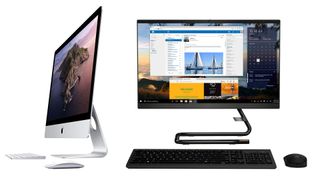
Check out our guide to the best home computers, with desktops from brands like Lenovo, Apple, and Dell..
